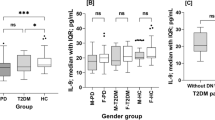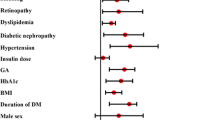Abstract
The aim is to investigate whether there is a difference in CA 19-9 levels between diabetes and healthy subjects except malignancies and associated factors with CA 19-9 in diabetes. We performed a retrospective analysis in 146 type 2 diabetes and 154 healthy subjects who visited our medical institution from 2005 to 2009. We compared the CA 19-9 in each group, and analyzed clinical and biochemical variables in diabetes. The average value of CA 19-9 in diabetes was higher than that of healthy subjects significantly (14.1 vs 8.1 U/mL, p < 0.01). CA 19-9 had a positive correlation with HbA1c (r = 0.22), fasting plasma glucose (r = 0.24), and C-reactive protein (r = 0.38) in diabetes (p < 0.05). 48 type 2 diabetes who showed decreased CA 19-9 during follow-up of 1.8 ± 1.0 years were also improved in glucose control state. The proportion of insulin use for glucose control was significantly higher in the group of CA 19-9 ≥ 37 U/mL (75.0 %) as compared with the group of CA 19-9 < 37 U/mL (34.0 %). CA 19-9 was significantly higher in the patients with diabetic peripheral neuropathy (DPN) as compared with those without DPN (p = 0.02). However, after excluding the influences from glycemic control state, significant difference was not observed. Our results indicate not only that CA 19-9 is influenced by glycemic control state but also can be elevated irrespective of any malignancy in diabetes. Therefore, CA 19-9 should be interpreted carefully in diabetic patients when CA 19-9 is used as the tool for malignancy screening.


Similar content being viewed by others
References
G.Y. Locker, S. Hamilton, J. Harris, J.M. Jessup, N. Kemeny, J.S. Macdonald et al., ASCO 2006 update of recommendations for the use of tumor markers in gastrointestinal cancer. J. Clin. Oncol. 24(33), 5313–5327 (2006)
M.D. Murray, F.R. Burton, A.M. Di Bisceglie, Markedly elevated serum CA 19-9 levels in association with a benign biliary stricture due to primary sclerosing cholangitis. J. Clin. Gastroenterol. 41(1), 115–117 (2007)
H. Yu, R. Li, L. Zhang, H. Chen, Y. Bao, W. Jia, Serum CA19-9 level associated with metabolic control and pancreatic beta cell function in diabetic patients. Exp. Diabetes Res. (2012). doi:10.1155/2012/745189
K. Gul, S. Nas, D. Ozdemir, M. Gumus, R. Ersoy, B. Cakir, CA 19-9 level in patients with type 2 diabetes mellitus and its relation to the metabolic control and microvascular complications. Am. J. Med. Sci. 341(1), 28–32 (2011)
O. Uygur-Bayramicli, R. Dabak, E. Orbay, C. Dolapcioglu, M. Sargin, G. Kilicoglu et al., Type 2 diabetes mellitus and CA 19-9 levels. World J. Gastroenterol. 13(40), 5357–5359 (2007)
G. Banfi, A. Ardemagni, S. Bravi, M. Pacchioni, P. Bonini, Are diabetic metabolic compensation and CA19.9 really correlated? Int. J. Biol. Markers 11(4), 207–210 (1996)
J. Everhart, D. Wright, Diabetes mellitus as a risk factor for pancreatic cancer. A meta-analysis. JAMA 273(20), 1605–1609 (1995)
J.M. Petit, G. Vaillant, N.O. Olsson, F. Guignier, S. Collignon, B. Verges et al., Elevated serum CA19-9 levels in poorly controlled diabetic patients. Relationship with Lewis blood group. Gastroenterol. Clin. Biol. 18(1), 17–20 (1994)
P.Y. Benhamou, J.P. Vuillez, S. Halimi, G. Meffre, I. Bachelot, Influence of metabolic disturbances of diabetes mellitus on serum CA 19-9 tumor marker. Diabetes Metab. 17(1), 39–43 (1991)
N. Nakamura, O. Aoji, T. Yoshikawa, K. Mori, S. Kajiyama, Y. Kitagawa et al., Elevated serum CA19-9 levels in poorly controlled diabetic patients. Jpn. J. Med. 25(3), 278–280 (1986)
N. Shimojo, K. Okuda, Clinical significance of Lewis blood-group phenotype and serum CA-19-9 analysis in the diagnosis of diabetic diseases. Nihon Rinsho 48(Suppl), 359–364 (1990)
H.Y. Yu, Y.Q. Bao, L. Zhang, J.M. Pan, W.P. Jia, Relation between the level of serum CA19-9 and glucose control in inpatients with diabetes. Zhonghua Yi Xue Za Zhi 90(6), 394–396 (2010)
M. Krzystek-Korpacka, M. Matusiewicz, D. Diakowska, K. Grabowski, K. Blachut et al., Acute-phase response proteins are related to cachexia and accelerated angiogenesis in gastroesophageal cancers. Clin. Chem. Lab. Med. 46(3), 359–364 (2008)
S.J. Wigmore, P.T. Todorov, M.D. Barber, J.A. Ross, M.J. Tisdale et al., Characteristics of patients with pancreatic cancer expressing a novel cancer cachectic factor. British J. Surg. 87(1), 53–58 (2000)
M. Siemionow, Y. Demir, Diabetic neuropathy: pathogenesis and treatment. J. Reconstr. Microsurg. 20(3), 241–252 (2004)
Conflict of interest
None.
Author information
Authors and Affiliations
Corresponding author
Rights and permissions
About this article
Cite this article
Kim, S.H., Baek, Co., Lee, K.A. et al. Clinical implication of elevated CA 19-9 level and the relationship with glucose control state in patients with type 2 diabetes. Endocrine 46, 249–255 (2014). https://doi.org/10.1007/s12020-013-0058-0
Received:
Accepted:
Published:
Issue Date:
DOI: https://doi.org/10.1007/s12020-013-0058-0




